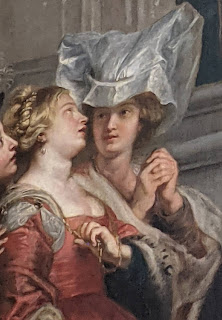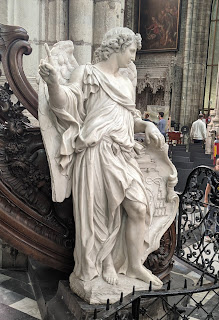
I am pretty sure that Steven and I would have made time to take a day trip to Ghent because of the interesting sights, its scenic canal scene, but, according to travel writer Rick Steves, St. Bavo's Cathedral was "a vast Gothic oyster housing the pearl of Flemish painting - the Ghent Altarpiece." That was pretty heavy praise and certainly helped tip the scales in ensuring we went to Ghent. The cathedral was the location of the altarpiece that kings, conquerors, and Nazis had attempted to steal "the symbol of civilization."
I had to lean way far back to capture this photo of the 290-ft.-tall church that was built from 1350-1559 on the site of an earlier church from 942. The cathedral was named for St. Bavo, an aristocrat from the Ghent area who gave up his worldly wealth to help the less fortunate.
The church was immense inside with 100-ft.-high ceilings.
The interior decorations and stained glass were, just as at the Church of St. Nicholas we'd seen earlier in Ghent, from the 19th-century because of the 16th-century iconoclasm when much of the Gothic ornamentation was torn down.
We only briefly admired the church before making a beeline to see the breathtaking altarpiece completed by Jan van Eyck after his older brother, Hubert, who had started the painting had died.
In the top central panel was the image of God attired in a rich red robe with his right hand raised as if in a solemn blessing. Admire the beautiful jewels van Eyck included in his masterpiece. The bottom of the robe was decorated with pearls with one of the many quotes woven in the altarpiece. His inscription said: "King of Kings" and "Behold the Lamb of God."
On His left was Mary dressed in her customary blue robe reading a book and, like God, also dripping in jewels.
Wearing a green robe over a camel-haired shirt was John the Baptist, flanking God on the other side.
Singing to God on either side were unique faces in heavenly choirs but instead of their playing harps as would be the case in altarpieces from an earlier period, these played a 15th-century organ. Travel writer Rick Steves, my go-to authority on our walking tours, wrote that hymnals from the era "indicated which face a singer would make when singing a particular note." As a result, professionals today could realistically estimate what note each angel is singing!
The panels on the far ends depicted Adam and Eve and were likely the first nude paintings north of the Alps done in the Renaissance era. If you peer closely or just click on the photo to make it bigger, you could see the hair on Adam's legs and feel the sense of movement in his legs.
The main scene in the lower panel depicted the Adoration of the Lamb, i.e. Jesus as the sacrificial lamb who saved the world. The lamb is shown atop an altar in a field. According to the book of Revelations in the Bible, all have made the journey to New Jerusalem as symbolized by the towers in the background to lavish praise on the Lamb of God.
I read that the lamb had special meaning in Ghent as its wool trade put the city on the map and was the source of its wealth. The venerated lamb, though it looks more like a full-grown sheep, was clearly the center of the altarpiece as it was placed on a vertical line descending from God to the dove to the lamb to the fountain.
Steves wrote that in symbolic terms "God sent the Holy Spirit to Christ on earth who gave his life to bring the faithful the waters of eternal life."
Hovering above the lamb is the dove or the Holy Spirit.
Around the altar van Eyck showed angels in white robes kneeling and praying to God. In the foreground was the fountain aka the Fountain of Life dispersing water and gems.
On the lower left, assorted saints and Jewish prophets gathered to show up before their savior behind Old Testament prophets reading from their books. Look at the wide diversity of people van Eyck included in each of these panels with people wearing different styles of clothing and headwear from throughout the world.
On the lower right were the white-robed 12 Apostles and the red-robed Church fathers.
Look at the popes waving palm branches on the upper left.
A group of virgins is gathering on the upper right. In the background behind the virgins were some of Ghent's landmarks still visible today.
The astonishing level of detail even included countryside scenes that had been painted with lots of identifiable species of plants and flowers! Van Eyck's lush details in the faces, robes, jewels, and plants "reinforced a theological message that was new to Europe: that the hand of God could be found in everyday things."
The lower left panels depicted more of the Adoration celebration as other worshippers continued to arrive. Arriving on horseback were knights and judges. The third and fourth characters on the left were likely portraits of Hubert and Jan van Eyck. The left panel, Just Judges, is a copy of the original that was stolen in 1934. More on that in a bit!
The lower right panels showed groups of pilgrims and hermits led by the great apostle, St. Christopher.
We couldn't leave the chapel without a further look at the monumental Adoration of the Mystic Lamb altarpiece van Eyck had created. As Steves eloquently wrote, "His work signaled a medieval world awakening to the new age of the Renaissance."
I was shocked to hear that the Ghent Altarpiece had likely been the most stolen art piece in existence as it had been the victim of six art thefts and also the focus of various international scandals. Do you remember my comment before about the movement by Protestant iconoclasts to rid churches in Bruges and Ghent of Catholic idolatry in the 16th-century? The same happened at St. Bavo's in 1566 when rioting Calvinists broke in with the intention of burning the altarpiece. Luckily, priests had the foresight to hide the masterpiece away in the cathedral tower.
More than two centuries later, the altarpiece's four central panels were carted off by Napoleon as war trophies and displayed in the Louvre from 1794-1815. Not to be outdone, the king of Prussia smuggled several panels to Germany in 1821 - those were only returned when the Treaty of Versailles which ended World War I forced Germany to return the panels to Ghent.
The Just Judges panel was stolen in 1934 during a break-in at St. Bavo's. The likely thief said on his deathbed that only he knew where the painting was! The heist has never been solved though the case remains open and leads are still being followed. The last of the saga concerns Hitler who coveted the altarpiece and his gang of art looters were most desperate to steal it above all other artworks. Fortunately, the Allied Monuments Men, a team of commando double agents ensured it remained in Belgium.
Above the cathedral's main altar was the statue of St. Bravo that showed the beloved local saint en route to heaven. Once a wealthy young soldier with an attitude, the 7th-century saint became a born-again Christian and rejected his former materialistic ways after his wife died.
As if the Van Eyck altarpiece wasn't already the piece de resistance in the cathedral, there was also a powerful painting by Peter Paul Rubens titled St. Bravo Entering the Monastery of Ghent. The painting shows the hometown's former bad boy turned saint in his red cloak on his "righteous course." Bavo is kneeling in front of the abbot to become a monk.
In the lower grouping, Rubens shows Bavo's estate manager distributing his master's worldly goods to the impoverished. What a joy seeing how dynamic the images were in this painting compared to the more static Adoration of the Mystic Lamb!
On the left, the manager is viewed by Bavo's daughter and her servant who are modeled after Rubens' wives, his older first wife, and his younger, more voluptuous second wife.
In the church's second chapel was a statue of Pater Damien, 1840-1889, was a Flemish missionary who traveled to Hawaii to minister to the lepers. He later died of leprosy there himself and was canonized in 2009. As one of the few saints with a US connection, Damien is important to both Hawaiians and Belgians.
The elaborate pulpit was carved in the 1740s from white stone and wood with golden highlights in a scene representing the tree of life as well as the tree of knowledge in a Counter-Reformation message.
Representing the power of her faith is the woman with the sun shining on her chest waking up the winged old man symbolizing time and indicating the Catholic faith must be re-awakened.
Don't you wonder what advice the two male angels are giving?
Just above the top of the pulpit are two industrious cherubs trying to raise the cross.
At the tippy top, our eyes followed a serpent's winding body to a plump angel taking the apple (of sin) from the snake's mouth. I don't know how much I would have listened to any sermon delivered by any priest from the pulpit as my eyes would surely have wandered to the exquisitely carved figures!


The Ghent Altarpiece was, without a doubt, a must-see sight not just in Ghent but in all of Belgium. Even though I previously hadn't been aware of its importance to people in the art world, to pilgrims, and to art thieves, it was certainly a breathtakingly beautiful piece of art. However, and this was a big however for us, Steven and I didn't come away with a positive feeling about St. Bavo's Cathedral. The tripling of the admission ticket to see the Altarpiece was hard to stomach and felt like gouging; the fact that no prices were listed; that no indication about what we could see was given even at a sky-high price; that there was abysmal signage throughout the Cathedral, with no information booklet, no signs by any of the private chapels indicating what was inside each one; and that there were no guides to ask anything of anywhere, was appalling and undeserving to those who made a mighty effort to see one of the wonders of the art world.

Next post: As Luxembourg wasn't allowing any Americans in to visit their country, we decided on the fly to visit Frankfurt, basically because it was relatively close to both Bruges where we were staying and Zurich, our next destination. Out hope had been to travel to Munich as it had some great places to tour but the thought of spending two full days on the train to get to and from the city nixed it and Frankfurt won out.
Posted on October 14th, 2021, from Milan, a city Steven and I have loved discovering and walking from end to end these last two days. I knew of the city's reputation for high fashion but little else before coming. It has surprised and delighted us at almost every turn.



















































No comments:
Post a Comment